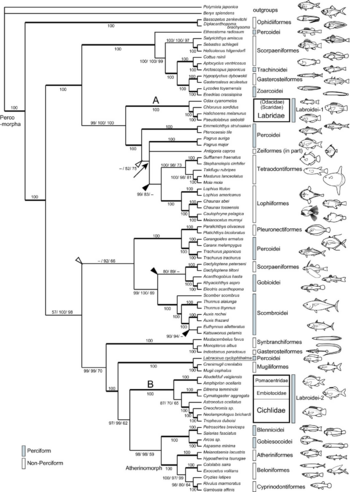Phylogenetic tree
Jump to navigation
Jump to search


Phylogenetic tree [r]: A representation of genetic similarity between taxonomic units. [e]
This article contains just a definition and optionally other subpages (such as a list of related articles), but no metadata. Create the metadata page if you want to expand this into a full article.
File:Phylogenetic Tree of life SVG.svg
PD Image
A phylogenetic tree of life, showing the relationship between species whose genomes have been mapped by humans. The very center represents the last universal ancestor of all life on earth. The different colors represent the three domains of life: pink represents eukaryota (animals and plants); blue represents bacteria; and green represents archaea. Our species (Homo sapiens) is second from the rightmost edge of the pink segment. The light and dark bands along the edge correspond to clades: the rightmost light red band is Metazoa, with dark red Ascomycota to its left, and light blue Firmicutes to its right.
A phylogenetic tree of life, showing the relationship between species whose genomes have been mapped by humans. The very center represents the last universal ancestor of all life on earth. The different colors represent the three domains of life: pink represents eukaryota (animals and plants); blue represents bacteria; and green represents archaea. Our species (Homo sapiens) is second from the rightmost edge of the pink segment. The light and dark bands along the edge correspond to clades: the rightmost light red band is Metazoa, with dark red Ascomycota to its left, and light blue Firmicutes to its right.

(CC) Image: Mabuchi et al., 2007
Phylogenetic relationships among the Labroid families of fish, based on whole mitochondrial DNA sequences. Note that the species of the Labridae and those of the remaining three labroid families (Cichlidae, Pomacentridae, and Embiotocidae) form different monophyletic groups, respectively.
Phylogenetic relationships among the Labroid families of fish, based on whole mitochondrial DNA sequences. Note that the species of the Labridae and those of the remaining three labroid families (Cichlidae, Pomacentridae, and Embiotocidae) form different monophyletic groups, respectively.